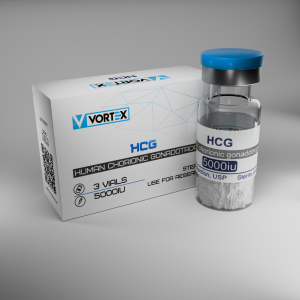Ipamorelin
NNC 26-0161 5mg
Ipamorelin 5mg
Stimulates the release of natural growth hormone (GH), promoting fat loss, muscle gain, recovery, and anti-aging effects. Known for its minimal side effects and targeted GH release.
Lyophilized sterile powder in a glass vial.
For dilution with bacteriostatic water or sterile water for injection.
Store refrigerated. Once reconstituted, it remains stable for 20–30 days under sterile conditions.
What is Ipamorelin?
Ipamorelin is a selective growth hormone secretagogue and ghrelin receptor agonist. It stimulates the pituitary gland to release endogenous growth hormone without significantly affecting cortisol or prolactin levels. This makes it a preferred option among peptides for GH stimulation.
It is widely used in bodybuilding, fat loss, and longevity protocols due to its clean safety profile and ability to enhance GH pulsatility without major side effects.
Benefits of Ipamorelin 5mg
Ipamorelin is appreciated for its focused mechanism and low-risk profile:
● Increases natural growth hormone and IGF-1 levels
● Supports fat metabolism and lipolysis
● Enhances lean muscle mass development
● Accelerates tissue repair and post-workout recovery
● Improves sleep quality and depth
● Exhibits anti-aging properties and cellular regeneration benefits
Possible Side Effects of Ipamorelin
Ipamorelin is generally well-tolerated, but potential side effects may include:
Mild headaches
Temporary dizziness
Injection site redness or discomfort
Mild fatigue
Water retention (rare)
Compared to other GH secretagogues, Ipamorelin shows minimal impact on cortisol, prolactin, and hunger levels.
Ipamorelin Dosage Guidelines
Dosage depends on goals such as fat loss, muscle gain, or recovery. Below are general guidelines based on fitness use:
● Standard dose:
- 100 mcg to 300 mcg per injection
- 1–3 times daily, depending on protocol
● Typical schedule:
- Morning, post-workout, and before bed
- Duration: 8–12 week cycles
Route: Subcutaneous injection, typically in the abdominal region.
Best Practices with Ipamorelin
- Use insulin syringes for accurate subcutaneous dosing
- Inject on an empty stomach or at least 1 hour after eating
- Avoid eating carbs/fats for 30–60 minutes post-injection
- Monitor IGF-1 levels if using long-term
- Store reconstituted peptide in the refrigerator at 2–8°C
Lifestyle and Dietary Considerations
To maximize the benefits of Ipamorelin, align your routine with growth-supportive habits:
- High-protein, moderate-carb, low-fat diet
- Prioritize strength training and recovery sessions
- Supplement with magnesium, zinc, arginine, and B-complex vitamins
- Avoid alcohol and inflammatory foods
- Sleep 7–9 hours per night for optimal GH release
When used responsibly in conjunction with exercise and recovery strategies, Ipamorelin can help amplify fat loss, muscle preservation, and anti-aging effects with minimal risk.








